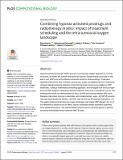Files in this item
Combining hypoxia-activated prodrugs and radiotherapy in silico : impact of treatment scheduling and the intra-tumoural oxygen landscape
Item metadata
| dc.contributor.author | Hamis, Sara | |
| dc.contributor.author | Kohandel, Mohammad | |
| dc.contributor.author | Dubois, Ludwig J. | |
| dc.contributor.author | Yaromina, Ala | |
| dc.contributor.author | Lambin, Philippe | |
| dc.contributor.author | Powathil, Gibin G. | |
| dc.date.accessioned | 2020-08-14T16:30:08Z | |
| dc.date.available | 2020-08-14T16:30:08Z | |
| dc.date.issued | 2020-08-03 | |
| dc.identifier.citation | Hamis , S , Kohandel , M , Dubois , L J , Yaromina , A , Lambin , P & Powathil , G G 2020 , ' Combining hypoxia-activated prodrugs and radiotherapy in silico : impact of treatment scheduling and the intra-tumoural oxygen landscape ' , PLoS Computational Biology , vol. 16 , no. 8 , e1008041 . https://doi.org/10.1371/journal.pcbi.1008041 | en |
| dc.identifier.issn | 1553-734X | |
| dc.identifier.other | PURE: 269606330 | |
| dc.identifier.other | PURE UUID: f831ef77-761d-490a-8f68-780bccbb74c5 | |
| dc.identifier.other | RIS: urn:8D88532E6BF1C84312FF576E1855261B | |
| dc.identifier.other | Scopus: 85089618220 | |
| dc.identifier.other | WOS: 000561794500007 | |
| dc.identifier.uri | https://hdl.handle.net/10023/20472 | |
| dc.description | SH was supported by the Medical Research Council [grant code MR/R017506/1] and Swansea University PhD Research Studentship. URLs: https://mrc.ukri.org/ and https://www.swansea.ac.uk/ MK acknowledges the financial support from the Canadian Institutes of Health Research (CIHR). URL: https://cihr-irsc.gc.ca LJD, AY and PL acknowledge financial support from European Research Council (ERC) advanced grant (ERC-ADG-2015, n 694812 – Hypoximmuno) and EUROSTARS (COMPACT 12053). URLs: https://erc.europa.eu/ and https://www.eurostars-eureka.eu The funders had no role in study design, data collection and analysis, decision to publish, or preparation of the manuscript. | en |
| dc.description.abstract | Hypoxia-activated prodrugs (HAPs) present a conceptually elegant approach to not only overcome, but better yet, exploit intra-tumoural hypoxia. Despite being successful in vitro and in vivo, HAPs are yet to achieve successful results in clinical settings. It has been hypothesised that this lack of clinical success can, in part, be explained by the insufficiently stringent clinical screening selection of determining which tumours are suitable for HAP treatments. Taking a mathematical modelling approach, we investigate how tumour properties and HAP-radiation scheduling influence treatment outcomes in simulated tumours. The following key results are demonstrated in silico: (i) HAP and ionising radiation (IR) monotherapies may attack tumours in dissimilar, and complementary, ways. (ii) HAP-IR scheduling may impact treatment efficacy. (iii) HAPs may function as IR treatment intensifiers. (iv) The spatio-temporal intra-tumoural oxygen landscape may impact HAP efficacy. Our in silico framework is based on an on-lattice, hybrid, multiscale cellular automaton spanning three spatial dimensions. The mathematical model for tumour spheroid growth is parameterised by multicellular tumour spheroid (MCTS) data. | |
| dc.format.extent | 27 | |
| dc.language.iso | eng | |
| dc.relation.ispartof | PLoS Computational Biology | en |
| dc.rights | Copyright: © 2020 Hamis et al. This is an open access article distributed under the terms of the Creative Commons Attribution License, which permits unrestricted use, distribution, and reproduction in any medium, provided the original author and source are credited. | en |
| dc.subject | QA Mathematics | en |
| dc.subject | NDAS | en |
| dc.subject.lcc | QA | en |
| dc.title | Combining hypoxia-activated prodrugs and radiotherapy in silico : impact of treatment scheduling and the intra-tumoural oxygen landscape | en |
| dc.type | Journal article | en |
| dc.description.version | Publisher PDF | en |
| dc.contributor.institution | University of St Andrews. Applied Mathematics | en |
| dc.identifier.doi | https://doi.org/10.1371/journal.pcbi.1008041 | |
| dc.description.status | Peer reviewed | en |
This item appears in the following Collection(s)
Items in the St Andrews Research Repository are protected by copyright, with all rights reserved, unless otherwise indicated.

